Metro Rail Transport(MRT)System in India
Kolkata Metro
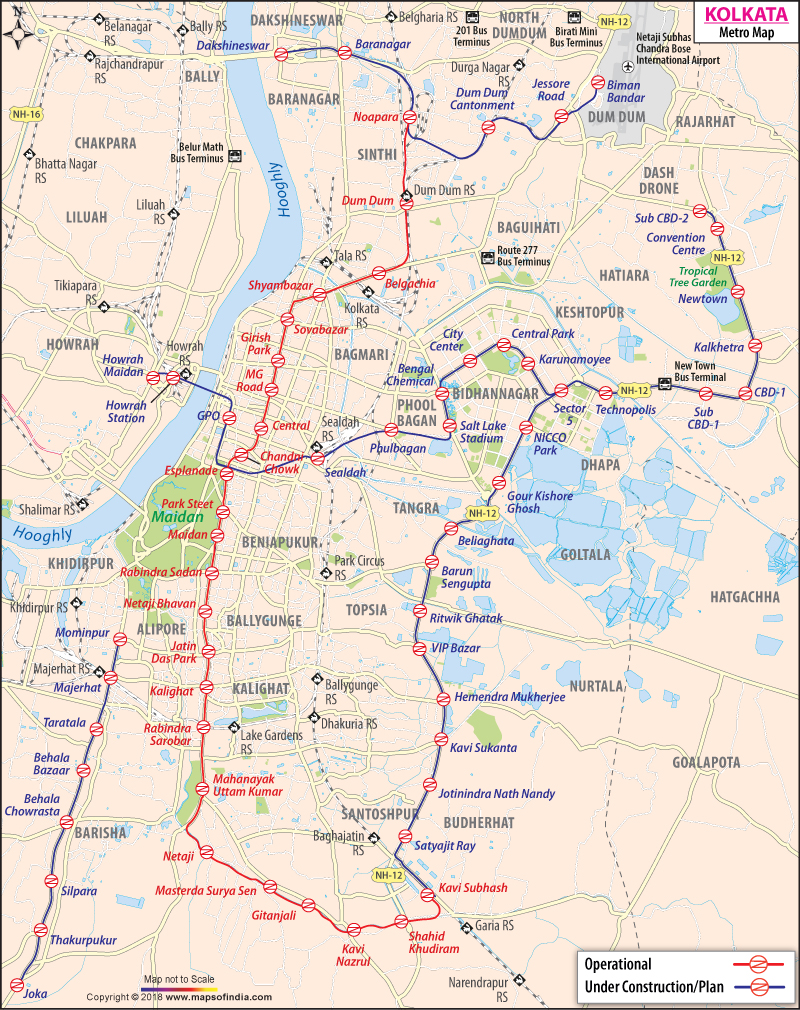
Kolkata Metro is the only metro service in the country functioning directly under the
Indian Railways, the foundation for this was laid as early as 1972.
Delays due to non-availability of sufficient funds, shifting of
underground utilities, court injunctions and irregular supply of vital
materials led to the commencement of services being pushed to 1984,
after which progressive construction followed leading to the completion
of the services of the entire stretch in 2005
Kolkata Metro is the 17th zone of the Indian Railways System
The Kolkata Metro serves the city of Kolkata,and the Districts of South 24 Parganas and North 24 Parganas in the the State of West Bengal,India
Kolkata Metro is the
first underground Metro railway in India.
Kolkata Metro extends from Noapara near
Netaji Subhas Chandra Bose Air Port, Kolkata to Kavi Subhash station
near Patuli, the busy North-South axis of Kolkata over a length of
27.223 kms.
The Metro railway, Kolkata was constructed progressively
from 1972 to 2013.
Phase-I a length of 16.450 kms from DumDum to
Tollygunge (Mahanayak Uttam Kumar) having been completed in 1995
Phase-II a length of 5.834 kms from Mahanayak Uttam Kumar to Kavi
Nazrul station is completed in August-2009.
The last leg upto Kavi
Subhash a length of 2.851 kms has been opened in October8,2010 for
commercial operation.
On 10th July 2013, Metro services further extended
from DumDum to Noapara(2.091 kms)
Delhi Metro
Delhi Metro is serving Delhi Metropolitan Area and its satellite cities of Gurgaon, Noida, Faridabad and Ghaziabad in the National Capital Region(NCR)of India
Delhi Metri Rail Corporation Limited(DMRC), a State Owned company with equal equity participation from Govt of India and Government of National Capital Territory of Delhi built and operates the Delhi Metro.DMRC is owned equally by the Delhi government and the Government of India.
Delhi Metro has been ranked second among 18 international Metro systems
in terms of overall customer satisfaction in an online customer survey.
Delhi Metro along with London DLR and Bangkok were the best three performers in the Net Promoters Score (NPS) category
Delhi Metro is also the World's 13th Largest Metro System in terms of length and 12th largest in terms of number of stations
As of June 2015, theDelhi Metro network consists of 5 colour-coded regular lines (Red, Blue, Green, Yellow, Violet), and a sixth express line, theAirport Express, with a total length of 194 kilometres (121 miles),serving 142 Stations (with 6 more Airport Express stations) of which 38 are underground, five are at-grade, and the rest are elevated
The Red Line was first line of the Metro to be opened and connects Rithala in the west to Dilshad Garden in the east, covering a distance of 25.09 kilometres (15.59 miles)
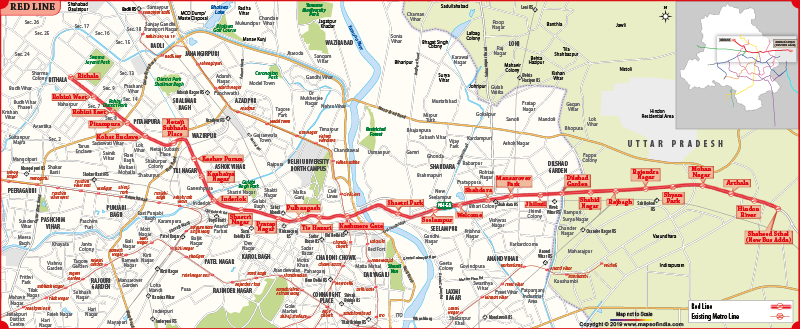
The Yellow Line was the second line of the Metro and was the first underground line to be opened.It runs for 44.36 kilometres (27.56 miles) from north to south and connects Jahangirpuri with HUDA City Centre in Gurgaon
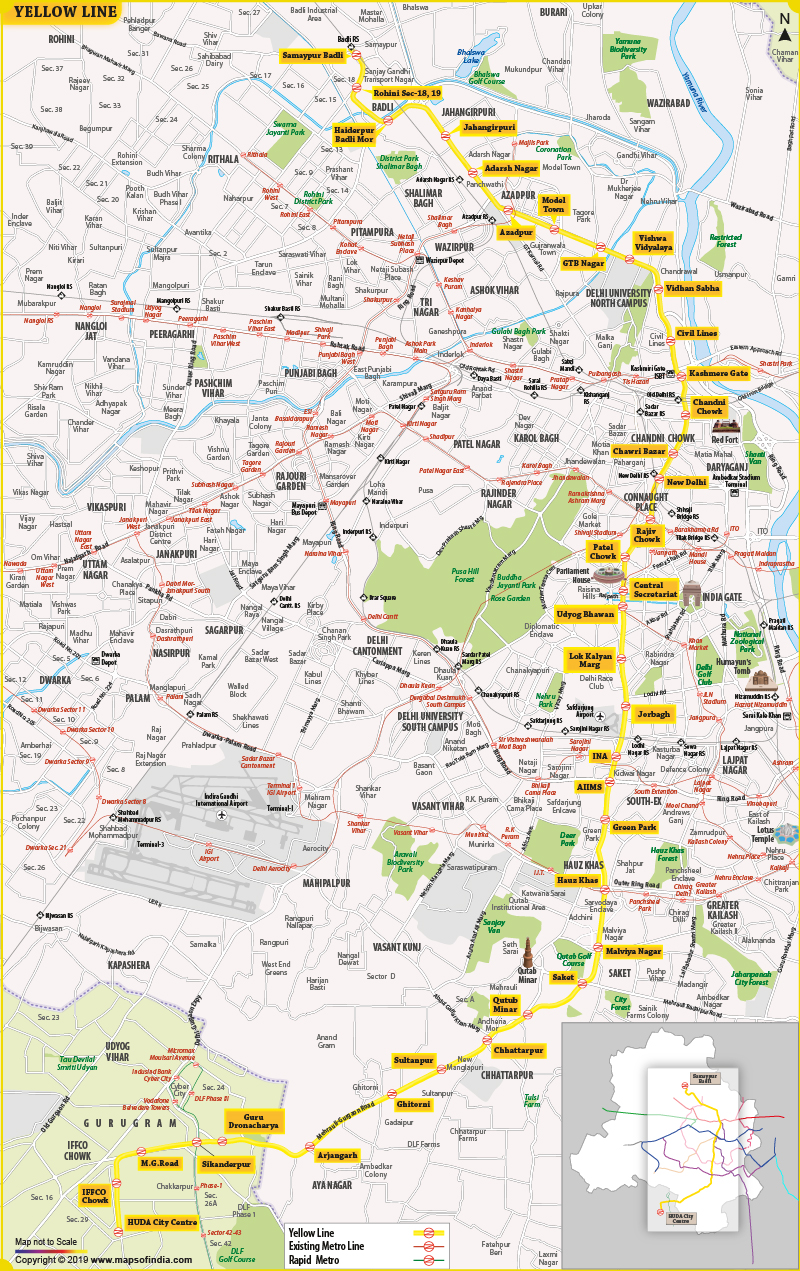
The Blue Line was the third line of the Metro to be opened, and the first to connect areas outside Delhi. Mainly elevated and partly underground,it connects Dwarka Sub City in the west with the satellite city of Noida in the east, covering a distance of 47.4 kilometres (29.5 miles)
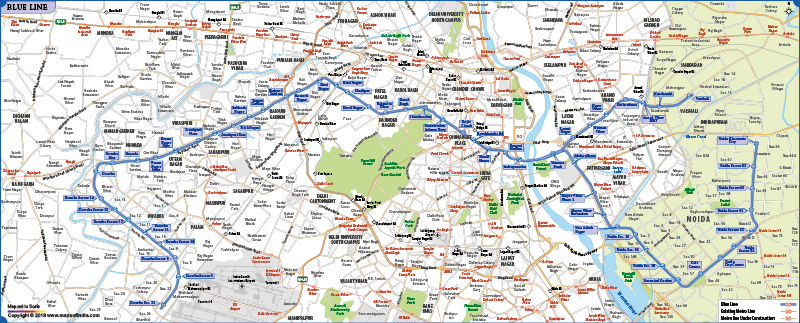
The Green Line was opened in 2010, Green Line (Line 5) is the fifth line of the Delhi Metro
network and the first line on standard gauge, as opposed to previous
broad gauge lines. It runs between Inderlok (station on the Red Line)
and Mundka with a branch line connecting the line's Ashok Park Main
station with Kirti Nagar station on the Blue Line. The completely
elevated line, built as part of the Phase-II of Delhi Metro runs mostly
along the busy NH 10 route in West Delhi. The line consists of 17
stations including an interchange station covering a total length of
18.46 km.The line was opened in two stages, with the 15.1 km Inderlok - Mundka
section opening on April 03,2010 and the 3.5 km Kirti Nagar - Ashok
Park Main branch line on August 27,2011
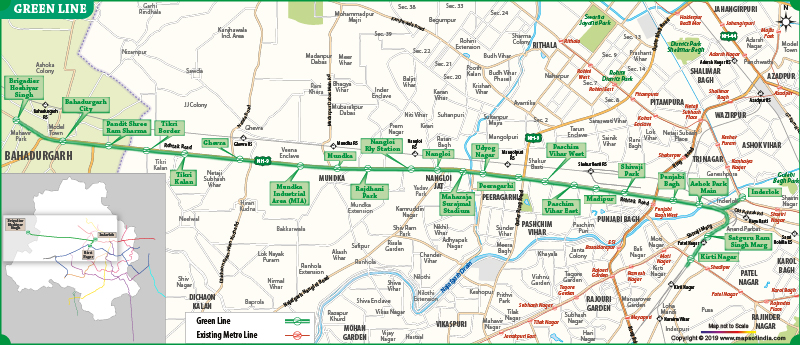
The Violet Line is the most recent line of the Metro to be opened, and
the second standard-gauge corridor after the Green Line. The 23.2 km
(14.4 mi) long line connects Badarpur to ITO, with 9 km (5.6 mi) being overhead and the rest underground. The first section between Central Secretariat and Sarita Vihar was inaugurated on October 03,2010,that just hours before the inaugural ceremony of the 2010 Commonwealth Games and connects the Jawaharlal Nehru Stadium, which was the venue for the opening and closing ceremonies of the event.On January 14, 2011, the remaining portion from Sarita Vihar to Badarpur
was opened for commercial service, adding 3 new stations to the
network and marking the completion of the line.The section between Mandi House and Central Secretariat, was opened on June 26,2014. The latest addition was a 971 metre section between ITO
and Mandi House, which was opened on June 8, 2015.

The Airport Express line runs for 22.7 km (14.1 miles) from New Delhi Railway Station to Dwarka Sector 21 linking the Indira Gandhi International Airport.Originally scheduled to open before the 2010 Commonwealth Games,the line failed to obtain the mandatory safety clearance and was
opened on Feb 24,2011, after a delay of around 5 months.

Delhi Metro has a combination of elevated, at-grade, and underground lines, and uses both Broad Gauge and Standard Gauge rolling stock.Four types of rolling stock are used -Mitsubishi Rotem broad gauge, Bombardier Movia, Mitsubishi Rotem standard gauge, and CAF Besain standard gauge
The trains are usually of four and six coaches, but due to increase in
the number of passengers, eight-coach trains are added on the Yellow
Line (Jahangirpuri to HUDA city centre) and Blue line (Dwarka Sector-21
to Noida City Centre/Vaishali).
The first line of the Delhi Metro was inaugurated by Atal Bihari Vajpayee, the Prime Minister of India,on 24 December 2002, and thus, it became the second underground rapid transit system in India after theKolkata Metro
The first phase of the project was completed in 2006,on budget and almost 3 years ahead of schedule
Phase I completed 58 stations and 65.0 km (40.4 miles) of route length,of which 13.0 km (8.1 mi) is underground and 52.1 km (32.4 mi) surface or elevated.
Phase II of the network comprises 124.6 km (77.4 miles)of route length and 85 stations and is fully completed, with the first section opened in June 2008 and the last line opened in August 2011
As of June 2015, with the completion of Phase I, Phase II and the
beginning of operations on Phase III, the Delhi Metro network comprises
five coloured lines (plus the Airport Express line), serving 142 metro
stations (with 6 more stations on the Airport Express line, for a total
of 148),and operating on a total route length of 194 kilometres (121 miles)







Supertech Studio Apartments in Noida
ReplyDeleteSupertech Up Country
ReplyDeleteFashion Crown housing complex included segregated spaces for #luxury #amenities. new modern buildwell
ReplyDeletePaarth Humming State is located at the #LucknowKanpur Road
ReplyDeletePaarth Humming State, #Lucknow
ReplyDelete